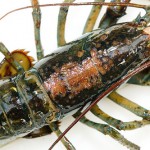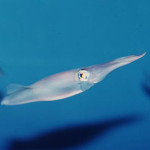For a long time when I thought of the violet snail a cold chill would run down my spine. I first learned about it after moving to a new town in a new state, knowing almost no one. I sat in my living room full of boxes, with my too-small lamp lighting the too-big desk, an evening blizzard raging outside. My life, for the first time in a long time, felt totally uncertain. Faced with this anxiety, I did what anyone would do: I made myself a cup of tea, settled under a blanket, and read a book about snails. And that’s when I discovered the violet snail: Janthina.
Imagine you are a Janthina snail, living on the surface of the open ocean, clinging to the edge of a raft. Miles of emptiness all around. In the day, rays of sunlight spear through the water, coming to a point so far below you can no longer see where they end. At night everything is black, you can almost feel the emptiness like a pressure, tingling on your skin. You cling to your raft as if your life depended on it, and it does. You don’t know how to swim.
You created the life raft you cling to—a collection of bubbles that keep you afloat. Your thin purple shell is heavy, and your body stout, if you let go you will will sink: first through the warm surface waters, and then the ocean will grow rapidly cold, light will fade and the pressure grow, it will take over two hours for your corps to hit the seafloor with a soft thud and a puff of muddy water. And so you hold on, and you build.
Your snail body is especially equipped to handle this strange world your ancestors somehow found themselves floating into. When you can, and when there’s need, you dip your head and upper body into the air. You curl your slimy underbelly into a ball, trapping a bubble and wrapping it in a layer of thick mucous. Carefully, you uncurl and stick this new bubble to your raft. Your snail slime hardens to a stiff rubbery texture, not easily popped. Sometimes your raft bumps into your prey— blue button jellies or Portuguese man-of-war— but you can’t steer or choose your direction out here in the open ocean, so much of the time, you simply wait. But you did not always live this way.
When you were young you lived below the surface, in the gentle embrace of the sea. You were free to move and hunt as you pleased. Your body was different, tender and round with a miniscule cup-shaped shell that covered your frame, and two small ‘wings’ that you used to swim. But it didn’t last. First, your vision went dim. Then you eyes began to break down, and blindness overtook you. Next, your ability to sense direction faltered, up and down became indistinguishable. No one knows quite how you made it to the surface. Some say you made a parachute of mucous that you used to sail slowly upwards. In the most poetic telling, you built yourself a minute bouquet of bubbles, clustered together at the end of a long string, like a handful of balloons. Blind and disoriented, you floated up into the unknown.
And then you hit something. The first boundary you’d ever felt—the soft rolling surface of the sea. Here you would complete your transformation into a young violet snail. Floating, unable to steer, you would have no need for eyes, no need for a sense of direction. This is where you would spend the rest of your life: at the mercy of the elements, suspended above the abyss.
Reading about the violet snail on that dark winter night, its life felt so precarious, so sad. But my friend Steve Haddock proposed another way of looking at things: one completely flipped around, literally. What if Janthina isn’t hanging over the abyss at all? There’s this scene in Pirates of the Caribbean where the ship flips upside down, and instead of sailing on the ocean, the ship sails on the sky. Perhaps to Janthina, the world is just like this. Instead of clinging to a raft, one mistake away from sinking, Janthina has a different view. Maybe to this snail, so perfectly adapted to life on the water’s surface, it’s not hanging upside down over the abyss, but instead resting right-side up on the top of the sky
Bibliography
Dan Laursen (1953) The Genus Ianthina: A Monograph.
Carol M. Lalli, Ronald W. Gilmer (1989). Pelagic Snails: The Biology of Holoplanktonic Gastropod Mollusks.







“Maybe to this snail, so perfectly adapted to life on the water’s surface, it’s not hanging upside down over the abyss, but instead resting right-side up on the top of the sky”
RR, you are a poet! Thank you for this beautiful read
Thank you María!
That is, and I say this without excessive irony, deep.
Reminds me of Peter Gabriel’s “Downside up” https://www.youtube.com/watch?v=WZ2hY6Fetw0
Totally!
haha! Technically it’s very shallow ;)
hello Rebecca
Hope you are well.
You should write about Janthina feasting on Velella.
Saw the snails eat velella for the first time this year in Villefranche. I guess thats why the snails are blue
that’s…
harrowing.
._.
Very true!